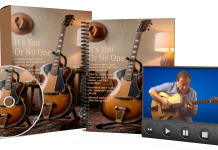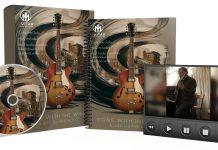This post may contain affiliate links. As an Amazon associate, Google associate as well as associate for other programs, Guitar & Music Institute may earn commissions from qualifying purchases.
As a beginner guitarist, you may be wondering where to start on your journey to mastering the guitar. It can be overwhelming with the vast array of techniques, scales, chords, exercises, and theory to learn. However, there are some essential guitar skills that every player should focus on developing. By mastering these skills, you will lay a strong foundation for becoming a proficient and versatile guitarist.
Whether you’re just starting out or looking to advance your playing, these guitar techniques and tips will help you on your musical journey. From beginner guitar lessons to advanced guitar techniques, let’s explore the essential skills that will take your guitar playing to the next level.
Key Takeaways:
- Proper finger placement is crucial for producing clear and clean notes. Focus on developing finger strength and precision through practice.
- Mastering chord transitions is essential for playing most songs on the guitar. Start slow, focus on accuracy, and gradually increase speed using a metronome.
- Understanding strumming patterns is vital for playing authentically and fluidly. Begin with basic downstrokes and gradually introduce upstrokes and varying rhythms.
- Fingerpicking adds complexity and texture to your playing, particularly in genres like folk, blues, and classical music. Start by assigning each finger of your picking hand to a string.
- Barre chords are challenging but essential for unlocking the full potential of the guitar. Learn to press down multiple strings across the fretboard with one finger to achieve new chord voicings and play in different keys.
Remember, practice is key to mastering these guitar skills. Use the resources available to you, whether it’s free online lessons or paid guitar books and downloads. Check out our latest free and paid guitar books and downloads at gmiguitarshop.com to enhance your learning experience.
Proper Finger Placement
Proper finger placement is crucial for playing the guitar effectively. By placing your fingertips just behind the frets, you can produce clear and clean notes. This technique requires finger strength and precision, which can be developed through daily practice of scales and chords.
When placing your fingers on the guitar strings, it’s important to avoid touching or muting adjacent strings. By keeping your fingers arched and using the tips rather than the pads, you can achieve optimal finger placement.
Developing finger strength will allow you to press down on the strings with enough force to produce a clear sound. This can be achieved through exercises that focus on finger dexterity and strength-building techniques.
Finger precision is equally important. By training your fingers to land directly behind the frets, you minimize the chance of buzzing or muted notes. Practicing scales and chords will help you improve your finger precision and accuracy over time.
Remember, mastering proper finger placement takes time and consistent practice. Be patient with yourself and strive for progress rather than perfection. With dedication and perseverance, you’ll develop the finger strength and precision necessary to become a skilled guitarist.
| Benefits of Proper Finger Placement | Techniques for Developing Finger Strength and Precision |
|---|---|
|
|
Chord Transitions
Transitioning between chords is a fundamental skill for playing most songs on the guitar. It allows you to seamlessly move from one chord to another and create a smooth and cohesive sound. While chord transitions may seem challenging at first, with practice and dedication, they can become second nature.
When starting out, it’s important to prioritize accuracy over speed. Take your time to ensure that each chord is played correctly before moving on to the next one. Focusing on accuracy will help you build a strong foundation and develop muscle memory.
A useful tool to aid your practice is a metronome. It helps you maintain a steady rhythm and tempo while transitioning between chords. By setting the metronome to a slow tempo initially, you can concentrate on making clean and precise chord changes. As you improve, gradually increase the speed to challenge yourself and enhance your agility.
Remember, consistency and regular practice are key to mastering chord transitions. Set aside dedicated practice sessions to focus on this skill, and you’ll soon notice significant improvement in your guitar playing.
Tips for Mastering Chord Transitions:
- Start slow and focus on accuracy before increasing speed.
- Use a metronome to maintain rhythm and tempo.
- Practice transitioning between common chord pairs.
- Break down complex chord progressions into smaller sections.
- Experiment with different finger placements to find the most comfortable and efficient positions.
Strumming Patterns
Different songs and music styles require different strumming patterns. Understanding these patterns is essential for playing authentically and fluidly. Starting with a basic downstroke pattern and gradually introducing upstrokes and varying rhythms will help you develop your strumming skills.

When it comes to strumming patterns on the guitar, the rhythm and fluidity of your playing are key factors in creating a captivating musical experience. Whether you’re strumming along to a lively folk song or rocking out to an energetic power chord progression, mastering strumming patterns will elevate your playing to a whole new level.
Strumming patterns dictate the rhythm and feel of a song, determining how the chords sound and creating the foundation for the overall groove. By varying your strumming patterns, you can add dynamics, accents, and emphasis to different parts of a song.
Basic Downstroke Pattern
One of the most fundamental strumming patterns to start with is the downstroke pattern. In this pattern, you’ll strum all the strings of the guitar in a downward motion. This simple pattern provides a solid foundation for building your strumming skills.
Introducing Upstrokes
Once you’ve mastered the downstroke pattern, it’s time to incorporate upstrokes into your strumming. Upstrokes involve strumming the strings in an upward motion. By combining downstrokes and upstrokes, you’ll create a more dynamic and rhythmic sound.
Varying Rhythms
Another important aspect of strumming patterns is the ability to vary the rhythm. Experiment with different rhythmic patterns, such as syncopation or accentuating specific beats. This will add depth and complexity to your playing, making it more engaging and interesting.
To further enhance your strumming skills, consider practicing with a metronome. This will help you develop a solid sense of timing and improve your ability to stay in sync with the rhythm of a song.
Remember, mastering strumming patterns takes time and practice. Start with simple patterns and gradually increase the complexity as you become more comfortable. Stay consistent with your practice routine, and soon you’ll be strumming with confidence, rhythm, and fluidity.
| Benefits of Mastering Strumming Patterns | Techniques to Develop |
|---|---|
| Enhances rhythm and timing skills | Downstroke pattern |
| Increases versatility in playing different music styles | Upstrokes |
| Adds dynamics and accents to your playing | Varying rhythms |
| Creates a solid foundation for building more advanced strumming techniques |
Check out our latest free and paid guitar books and downloads at https://gmiguitarshop.com/ to further enhance your guitar skills and explore a wide range of resources.
Fingerpicking
Mastering fingerpicking technique allows you to create intricate and complex soundscapes on the guitar. It adds a unique texture to your playing, making each note resonate and blend harmoniously. Fingerpicking is widely used in various music genres, including folk, blues, and classical music.
To begin honing your fingerpicking skills, start by assigning each finger of your picking hand to a specific string. Typically, the thumb is responsible for playing the bass strings, while the other fingers handle the higher strings.
Take the time to practice plucking each string individually to develop accuracy, control, and finger independence. This will help you build the foundation for more advanced fingerpicking patterns.
As you progress, you can explore different fingerpicking patterns, such as the Travis picking style used in folk and country music. These patterns involve alternating bass notes with melody notes, creating a rich and intricate melody-rhythm combination.
Remember, fingerpicking is not limited to a specific skill level. Whether you’re a beginner or an experienced guitarist, there are always new techniques and patterns to explore. Dedicate regular practice sessions to fingerpicking, and soon you’ll be able to create beautiful and captivating melodies on your guitar.

The Benefits of Fingerpicking
- Complex Soundscapes: Fingerpicking allows you to create vibrant and multifaceted musical arrangements, making your guitar playing more expressive and dynamic.
- Genre Versatility: Fingerpicking is a fundamental technique in genres like folk, blues, and classical music, enabling you to explore new musical styles and expand your repertoire.
- Enhanced Finger Control: By practicing fingerpicking, you’ll develop dexterity and coordination in your picking hand, which will translate to improved overall guitar playing.
- Emotional Expression: Fingerpicking techniques, such as arpeggios and fingerstyle playing, allow you to convey a wide range of emotions through your guitar, adding depth and richness to your musical expression.
If you want to delve deeper into the art of fingerpicking, our website offers a variety of free and paid guitar books and downloads.
Barre Chords
Barre chords can be challenging for beginners, but they are essential for unlocking the full potential of the guitar. A barre chord involves pressing down multiple strings across the fretboard with one finger, often the index. Learning barre chords allows for new chord voicings and easier playing in different keys.
If you’re ready to take your guitar playing to the next level, mastering barre chords is a must. With barre chords, you can expand your repertoire of chord voicings and play in different keys with ease. By using the barre technique, you can create full, rich sounds that are not possible with open chords alone.
When playing barre chords, it’s important to maintain good finger strength and accuracy. Here are a few tips to help you master this technique:
- Start by practicing the basic barre shape using your index finger to press down all the strings on a fret. This shape will serve as a movable chord form.
- Use the edge of your finger to create a solid bar across the fretboard, ensuring that all the strings are pressed down evenly.
- Experiment with different chord shapes and progressions using barre chords. This will help you familiarize yourself with the various chord voicings available.
- Practice transitioning between different barre chord shapes and open chord shapes to improve your playing versatility.
- Use a metronome to practice playing barre chords in different rhythms and tempos. This will help you develop a strong sense of timing and fluidity.
Remember, mastering barre chords takes time and practice. Don’t get discouraged if you find them difficult at first. With consistent practice and perseverance, you’ll soon be able to incorporate barre chords into your playing effortlessly.
For more detailed lessons on barre chords and other advanced guitar techniques, check out our latest free and paid guitar books and downloads at https://gmiguitarshop.com/.
| Benefits of Barre Chords | Challenges of Barre Chords |
|---|---|
|
|
Palm Muting
If you want to add a powerful and rhythmic element to your guitar playing, palm muting is a technique you need to master. Used in various genres such as rock and pop, palm muting involves lightly resting the palm of your strumming hand on the strings near the bridge while playing, creating a muted and percussive sound. This technique adds dynamics and rhythm to your playing, allowing you to control the intensity and groove of your guitar parts.
To palm mute effectively, follow these steps:
- Place the edge of your palm against the strings just above the bridge of your guitar.
- Lightly touch the strings with your palm to partially dampen the sound.
- Experiment with the amount of pressure applied to achieve the desired level of muting.
- Try different palm positions to alter the tone and sound of your muted notes.
Palm muting is commonly used in guitar riffs and power chord progressions to create a tight and aggressive sound. It enhances the rhythmic aspect of your playing, making your guitar parts stand out in a mix.
Remember to practice palm muting in conjunction with other techniques such as alternate picking and strumming patterns to incorporate it seamlessly into your playing.
| Benefits of Palm Muting |
|---|
| Enhances dynamics and rhythm in your playing |
| Adds a percussive element to your guitar parts |
| Creates a tighter and more aggressive sound |
| Allows for control over the intensity and groove of your playing |
Bends and Slides
Bends and slides are powerful techniques that can add depth, emotion, and flair to your guitar solos. With bends, you can create those soulful, expressive notes by raising the pitch of a string. By pushing or pulling the string in an upward or downward motion while fretting a note, you can bend the pitch to your desired level. Bends allow you to make your guitar ‘sing’ and convey a range of emotions in your playing.
Slides, on the other hand, involve moving a fretted note seamlessly up or down the fretboard. This technique adds a smooth transition between different notes and creates a sense of movement in your playing. Slides can be short and subtle, or long and dramatic, depending on the effect you want to achieve. They are frequently used to connect different positions on the guitar neck and enhance the flow of your solos.
While bends and slides can be challenging techniques to master, the effort is well worth it. Practice these techniques slowly and gradually increase the difficulty as you become more comfortable. Experiment with different bending angles and slide lengths to discover your unique style and sound. With time and dedication, bends and slides will become invaluable tools in your guitar playing arsenal.
Want to explore more about bends, slides, and other expressive techniques? Check out our latest free and paid guitar books and downloads at https://gmiguitarshop.com.
FAQ
What are the essential guitar skills every player must master?
The essential guitar skills every player must master include proper finger placement, chord transitions, strumming patterns, fingerpicking, barre chords, palm muting, and bends and slides.
Why is proper finger placement important for playing the guitar effectively?
Proper finger placement is crucial for producing clear and clean notes. By placing your fingertips just behind the frets, you can achieve this. Daily practice of scales and chords helps develop the finger strength and precision needed for proper finger placement.
How can I improve my chord transitions?
Transitioning between chords can be challenging at first, but with practice, it becomes second nature. Start by practicing slow and focusing on accuracy before increasing speed. Using a metronome can help maintain rhythm during chord transition exercises.
What should I know about strumming patterns?
Different songs and music styles require different strumming patterns. Understanding these patterns is essential for playing authentically and fluidly. Start with a basic downstroke pattern and gradually introduce upstrokes and varying rhythms to develop your strumming skills.
How do I learn fingerpicking?
Fingerpicking adds complexity and texture to your guitar playing. Start by assigning each finger of your picking hand to a string and practice plucking individual strings. Gradually progress to patterns. Fingerpicking is particularly important in genres like folk, blues, and classical music.
Why are barre chords important?
Barre chords can be challenging for beginners, but they unlock the full potential of the guitar. By pressing down multiple strings across the fretboard with one finger, often the index, you can play new chord voicings and easily transpose to different keys.
What is palm muting?
Palm muting is a technique used in various genres to create a muted and percussive sound. It involves lightly resting the palm of your strumming hand on the strings near the bridge while playing. Palm muting adds dynamics and rhythm to your playing.
What are bends and slides?
Bends and slides are expressive techniques used to add emotion and flair to guitar solos. Bending involves raising the pitch of a string by pushing or pulling it, while sliding involves moving a fretted note up or down the fretboard. Mastering these techniques allows for powerful expression in your playing.
Source Links
- https://www.metronomeonline.com/checklist-guitarist-learn
- https://guitarsonmain.com/blogs/news/7-essential-guitar-techniques-every-beginner-should-learn
- https://www.theworkingguitarist.com/2021/07/12/the-most-important-professional-guitarist-skill-master-the-guitar-fretboard/
This post may contain affiliate links. As an Amazon associate, Google associate as well as associate for other programs, Guitar & Music Institute may earn commissions from qualifying purchases.


























